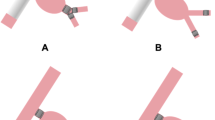Abstract.
Introduction: Isolated iliac artery aneurysms (IAA) are rare. The rupture risk, however, is high and the diagnosis can be difficult. The aim of this study was to report the frequency, morphology and outcome of these lesions. Methods: Retrospective analysis of the medical data of all patients treated for IAA from 1990 to 1999. Results: Fifty-nine consecutive patients, 55 (93 %) male and 4 (7 %) female, were included in the study. The median age was 68 (48–86) years. During the same time period, 741 consecutive patients with aorto-iliac aneurysms were treated; thus the frequency of IAA was 8 %. The median diameter of the IAA was 7 (3–12) cm. Most patients had at least one risk factor. IAA were unilateral in 40 (68 %) or bilateral in 19 (32 %) patients and affected the common iliac artery in 25 (19 %), the internal iliac artery in 11 (19 %) and simultaneously the common and internal iliac artery in 21 (36 %) patients. Additional involvement of the external iliac artery was noted in 2 (3 %) patients. Thirty-six (61 %) patients with IAA underwent elective treatment while 23 (39 %) patients had to be treated on an emergency basis. Endovascular stent grafts were inserted in 2 patients. Overall mortality was 10 % (n = 6), 2.8 % (n = 1) in asymptomatic and 22 % (n = 5) in symptomatic or ruptured IAA. Overall morbidity in this study was 30 %. The median follow-up of the patients was 36 (2–120) months. Discussion: Surgical therapy in patients with asymptomatic IAA can be performed with a reasonable mortality. However, mortality and morbidity in patients with symptomatic or ruptured IAA remains high. Postoperative long-term results are excellent. The value of endovascular therapy for IAA has yet to be determined.
Zusammenfassung.
Einleitung: Isolierte Aneurysmen der Iliacalarterien (IAA) sind selten, weisen jedoch ein hohes Rupturrisiko auf. Die klinischen Symptome symptomatischer oder rupturierter IAA sind teilweise unspezifisch und häufig irreführend. Ziel dieser Arbeit ist eine Analyse der Resultate, der Morphologie und der Häufigkeit von IAA in unserem Patientengut. Methodik: Retrospektive Datenanalyse aller Patienten mit IAA die zwischen 1990–1999 behandelt wurden. Ergebnisse: Das Patientengut umfasste insgesamt 59 Patienten, 55 (93 %) Männer und 4 (7 %) Frauen mit einem Durchschnittsalter von 68 (48–86) Jahren. Die Häufigkeit der IAA in unserem Patientengut beträgt 8 %. Der durchschnittliche Durchmesser der IAA betrug 7 (3–12) cm. Die meisten Patienten wiesen einen oder mehrere Risikofaktoren auf. 25 (68 %) Patienten hatten unilaterale und 19 (32 %) bilaterale Aneurysmen. Bei 25 (42 %) Patienten war die A. iliaca communis, bei 11 (19 %) die A. iliaca interna und bei 21 (36 %) die A. iliaca communis und interna betroffen. Eine Mitbeteiligung der A. iliaca externa bestand in 2 (3 %) Fällen. 36 (61 %) Patienten wurden elektiv behandelt, während 23 (39 %) mit symptomatischen (n = 10; 17 %) oder rupturierten (n = 13; 22 %) IAA notfallmäßig operiert wurden. 2 Patienten wurden endovasculär mittels Stentprothese behandelt. Die Gesamtmortalität betrug 10 % (n = 6), respektive 2,8 % (n = 1) bei den asymptomatischen und 22 % (n = 5) bei den symptomatischen oder rupturierten IAA. Bei 18 Patienten traten postoperative oder postinterventionelle Komplikationen auf, was einer Morbidität von 30 % entspricht. Die durchschnittliche Nachkontrollzeit betrug 36 (2–120) Monate. Diskussion: Im Gegensatz zu den rupturierten oder symptomatischen IAA, weist die Therapie der asymptomatischen IAA heute eine niedrige Mortalität auf. Die chirurgischen Spätresultate der IAA sind ausgezeichnet, während der Stellenwert der endovasculären Therapie noch zu definieren ist.
Similar content being viewed by others
Author information
Authors and Affiliations
Rights and permissions
About this article
Cite this article
Reber, P., Brunner, K., Hakki, H. et al. Häufigkeit, Klassifikation und Therapie der isolierten Beckenarterienaneurysmen. Chirurg 72, 419–424 (2001). https://doi.org/10.1007/s001040051324
Issue Date:
DOI: https://doi.org/10.1007/s001040051324




